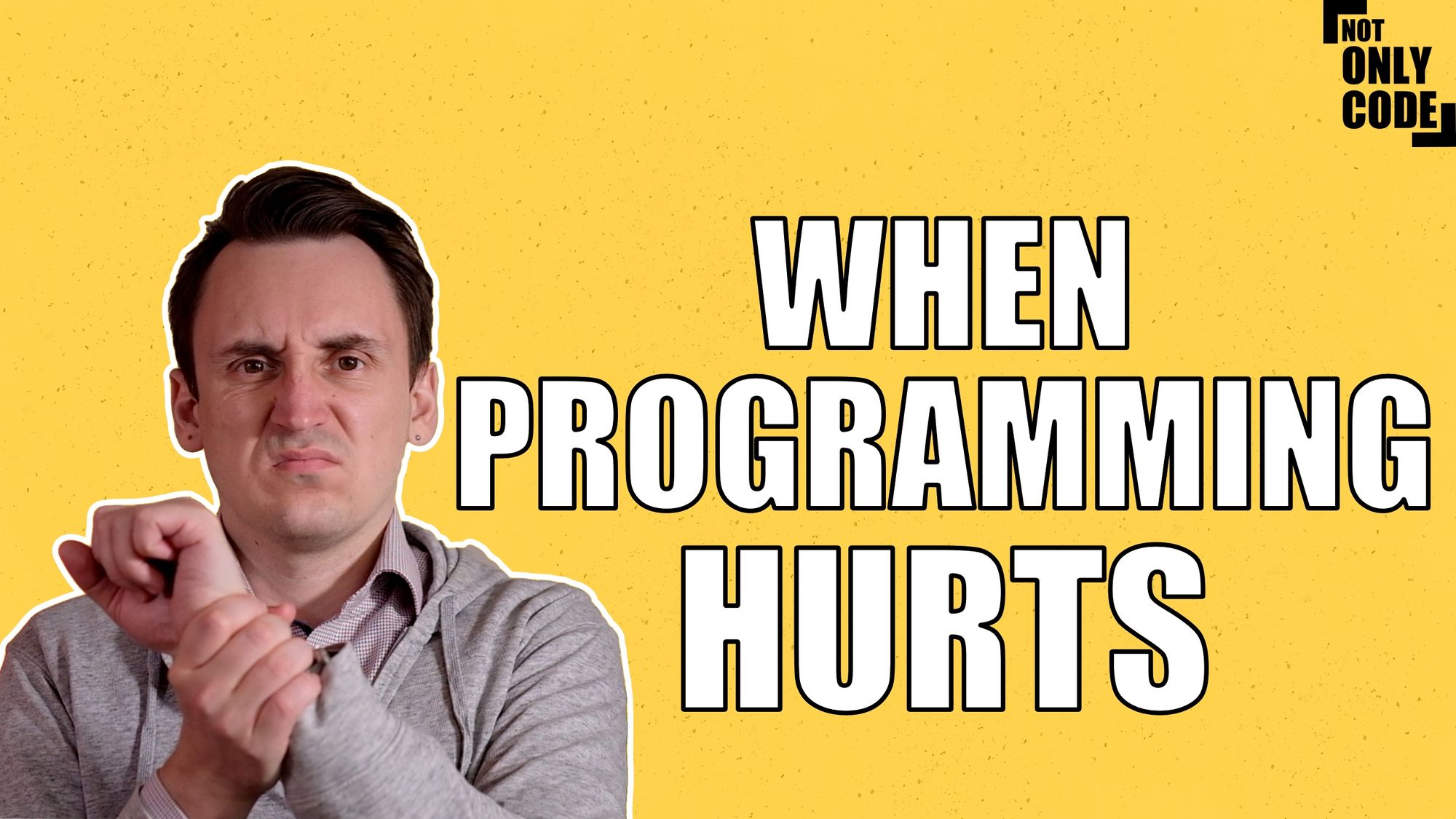Programming injuries - fix your habits before it gets bad
In this video I'm talking about 2 health problems common among programmers: RSI (specifically wrist pain-ralated) and lower back pain. I'm talking about minimizing the issues via building good habits and choosing proper equipment.

In this video I'm talking about 2 health problems common among programmers: RSI (specifically wrist pain-ralated) and lower back pain. I'm talking about minimizing the issues via building good habits and choosing proper equipment.
Notes
Programming and health problems
- you won't find us on the list of most risky professions
- our job is mostly about sitting in a room, without much movement
- the lack of movement and the unhealthy habits make the health problems less sudden, but not less severe
- today I focus on 2 issues: back problems and arm problems
- I had to deal with both of them
- I still have problems from time to time
- through some good habits I minimized the issues
Sitting and standing - help your back
- back pain is very common, not only among programmers
- prolonged sitting causes plenty of problems
- we know how to minimize the risk, but people often don't care
Chair
- buy a proper office chair
- regulated height (standard)
- regulated depth (especially if you're tall/short)
- regulated armrests (width/angle/height, length)
- regulated lumbar support
- make sure to either buy the chair that fits your body or that you can adjust to your body
- the fancy gaming "racing-style" chairs
- some of them are ergonomic
- but big part of them is fancy look
- if you decide to buy one, pay attention to adjustability
- do not fall for flashy colors, fancy pillows and leg rest
Posture
- good chair won't fix everything
- pay attention to your posture!
- make sure to get your ass up every hour and move around
Desk
- regulated desks (that you can use while sitting or standing) are great
- but what's important than not sitting is actually moving, so standing in one position the whole day is not that great
- make sure to match the height of desk and chair (and if not possible - get some feet support)
Wrists pain
- be careful - this shit might get bad
- I've had this problem and in the past and it was painful
Problem
- the position of the wrist when using mouse/keyboard is unnatural in 3 different ways
- the hand is parallel to desk, while natural position is 90 degrees
- the wrists are turned, because keyboard is straight, but our arms position is not (and because keyboard is short, so we can't keep our arms at 90 degrees angle)
- the wrists are turned up (depending on a keyboard)
Ergonomic keyboard
- there are plenty of options
- you can use curly keyboard like Microsoft one that allows your hands to stay in more natural position
- you can use split keyboard, that also has advantages (your arms can be straight)
- you can find tilted keyboard that will allow you to keep your wrists in more natural position
- you can use palm rests
- the most poular keyboards like laptop keyboards or apple magic keyboard are not ergonomic - they look great and I love using the magic keyboard, but damn it is not ergonomic
- using split, tilted keyboard has helped me to get rid of pain in my wrists in the past
Keyboard layout (not made it to the video)
- if you use some particular keyboard shortcuts you can try to customize keyboard settings (that depends on operating system, I used Karabiner for Mac)
- if you really want to change the way you type you can consider different keyboard layout (I currently try Colemak)
- changing layout will make it more difficult to use other people's computers though, so be careful
Mouse/trackpad
- similar thing with mouse or trackpad
- trackpads are awesome, but again you keep your hand flat and that's not healthy
- mouse is a bit better but it has also a lot of traps - if you choose mouse that's too big or too small, your fingers will be in unnatural position
- check some ergonomic mouse, I guess the most popular mouse atm is Logitech MX Master, and it is not a marvel of ergonomics, but it is ok
- I use MX Vertical, while it lacks some features of the Logitech MX, it is very comfortable
- I find it hard to go back to trackpad right now, even though I miss some features
Do some sports
- seriously, pick up some sport that forces you to move your ass there and back every once a while
- no, no esports
- no, no chess
- at least go to the gym, lift something (if nothing else then your own butt doing pull ups)
- team sports are great because you have someone to do it with
Equipment presented in the video
- Apple Magic Keyboard - which I like but avoid due to wrispain * Apple Magic Trackpad - same problem
- Matias Ergo Pro - keyboard I used a few years ago, the design is absolutely wonderful; I had some issues with the quality though, I hope they're fixed now
- Ergodox EZ - a keyboard I've bought recently and I'm still learning * Logitech MX Master (https://www.logitech.com/en-us/products/mice/mx-master-3.910-005620.html) - I have prevoius version, MX 2, which I find great, especially with horizontal scroll and programmable buttons
- Logic tech MX Vertical - mouse I'm using these days, it has fewer features than one above, but is more ergonomic
- bonus mention: Microsotft Ergonomic Keyboard - simpler and cheaper than other mentioned keyboards - still, thanks to "curly" design it helps with the "twisted" wrist issue
🪑 chairs - I don't have any specific recommendations. Among the office chair, Herman Miller produces by far the mort popular (and pricy) ones, but I've never tried them, it seems to me they're not very adjustable, but maybe they make up for it in another way? I'm using one by a not really known Dutch company. When it comes to gaming chair, I haven't tried any well-known brand so I can't say much about them. The lesser-known ones I've tried were terrible in terms of ergonomy (I owned one and quickly got rid of it), so I recommnend going through adjustement checklist before making a decision.

